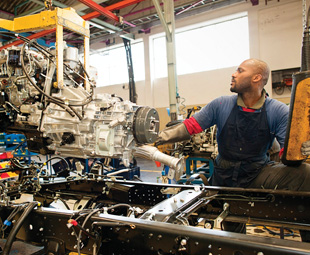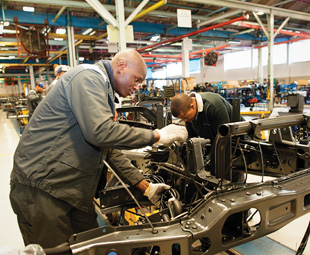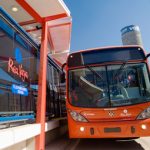Three-pointed Star for Rea Vaya

A recent tender awarded to Mercedes-Benz South Africa has allowed the company to enter the local Bus Rapid Transit arena.
The Rea Vaya Phase 1B tender has been awarded by the City of Johannesburg to Mercedes-Benz South Africa’s (MBSA) Sandown Motor Holdings. The Phase 1B is some 18 km long and covers 10 stations. It starts in Soweto and passes through several suburbs before linking to the Johannesburg CBD.
The tender will see MBSA’s Bus and Coach Division supply 134 Euro-6, 0500M city bus chassis, of which 41 will be articulated buses. All the chassis will be assembled at MBSA’s plant in East London where the dedicated bus assembly line will be reopened.
Dirk Ansorge, bus and coach manager of MBSA, says: “Mercedes-Benz South Africa is proud to be the supplier of the bus chassis. Notably, this is the first BRT project for Mercedes-Benz in this country and it will enable us to transfer the company’s extensive experience and knowledge in worldwide BRT to South Africa. We value this opportunity to provide reliable and efficient mobility to the people of Johannesburg.”
The buses will be imported from Brazil where their powertrains are assembled. The chassis will be shipped to South Africa in complete knock-down kits. MBSA will increase the amount of local content put into the bus chassis and aims to provide increased employment and skills development.
 Aiding the use of locally produced components is a rule stipulating that 80 percent of the bus body must be made up of local content. These items include tyres, wiring looms, piping, fuel tanks, driver and vehicle management systems and the oils and lubricants.
Aiding the use of locally produced components is a rule stipulating that 80 percent of the bus body must be made up of local content. These items include tyres, wiring looms, piping, fuel tanks, driver and vehicle management systems and the oils and lubricants.
Ansorge explains the assembly arrangements in finer detail: “We will start assembling the chassis and release them to the body builder from the first week in June through to the second half of October. The plan is to assemble up to 10 chassis per week.”
It is believed that, by offering efficient and attractive public transport, the BRT system will reduce noise, congestion and the environmental damage caused by carbon emissions from private vehicles.
Ansorge elaborates: “One of the challenges in cities with rapidly growing use of private vehicles is carbon emissions. Harmful environmental pollution must be reduced, as well as consumption of energy produced from fossil fuels.” He adds that these goals can be achieved by implementing an efficient and attractive public transport system such as BRT.
This is the type of system that is being demanded in Johannesburg and other big cities around the country and may soon become a reality. BRT, he believes, “bodes well for the City of Johannesburg becoming a ‘World Class African City’”.
Ansorge believes that MBSA chassis provide the ideal base for building buses that offer even higher levels of efficiency and comfort. “One of the important pillars that determine the success of BRT is the uptime factor. We will provide all the necessary product support to ensure that uptime is at its peak. Our chassis are reliable and our after-sales division, an integral part of our value chain offering, will be at hand to ensure that the fleet performs at its best.”
He adds that MBSA’s commitment does not end with the chassis and that it will take responsibility for the entire product for the duration of the contract, including the inspection and sign-off of every bus body that is built.
As a subsidiary of MBSA, Sandown Motor Holdings will offer a dedicated BRT service and after sales service. The MBSA commercial vehicle facility is in Stormill, which is two kilometres away from the current Dobsonville depot. In addition, there will also be mobile service teams to provide assistance if need be.
 FleetBoard professional will offer product familiarisation and driver training as a part of the value chain offering. Ansorge explains: “At MBSA we believe in building sustainable business relationships with our clients. We further believe that the relationship can only develop when value is added to the client’s business.”
FleetBoard professional will offer product familiarisation and driver training as a part of the value chain offering. Ansorge explains: “At MBSA we believe in building sustainable business relationships with our clients. We further believe that the relationship can only develop when value is added to the client’s business.”
Ansorge adds that MBSA will offer the City of Johannesburg the technical expertise and management skills that will allow the bus drivers to extract the maximum benefits from the new technology and features in these buses.
MBSA’s holding company, Daimler AG, has successfully implemented the introduction and provision of buses in several cities including Istanbul, Nantes, Mexico City and Bogotá. Some 17 000 Mercedes-Benz buses are operating in more than 20 BRT systems around the world.
The Daimler BRT team offers support during the planning, implementation and further development of customised Bus Rapid Transit concepts. Included in this team are specialists in traffic and transport planning, engineers, strategists and other experts from around the world.
The first BRT system originated in Latin America in the 1970s – when rapid growth in its urban populations began causing tremendous problems in urban traffic congestion. The combination of over-population and lack of finance meant that passenger vehicle-based infrastructure was not possible. This paved the way for a more cost-effective method for transporting masses of people. Thus, the BRT paradigm was invented and is now world renowned for its efficiency and ability to provide quality public transport.
Published by
Focus on Transport
focusmagsa




